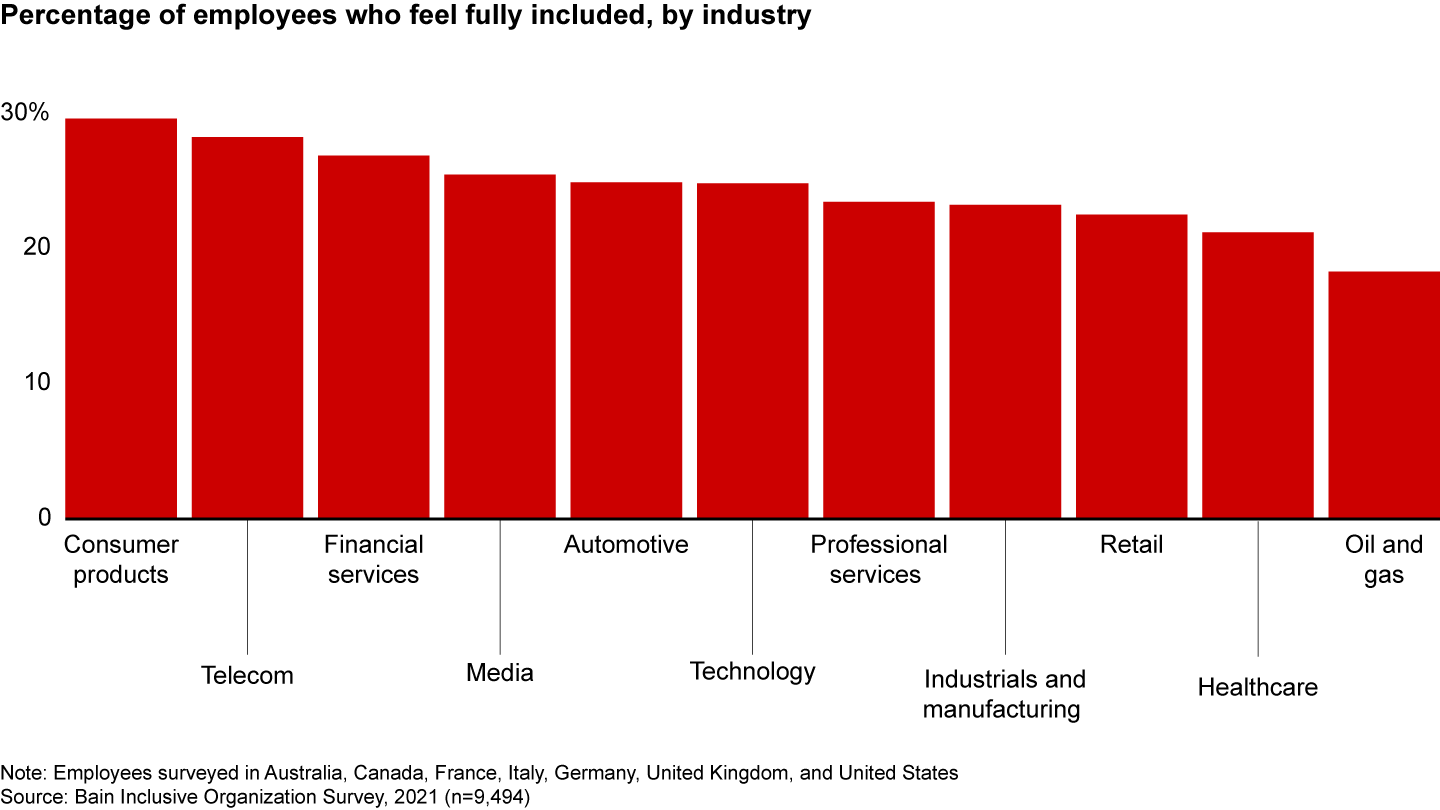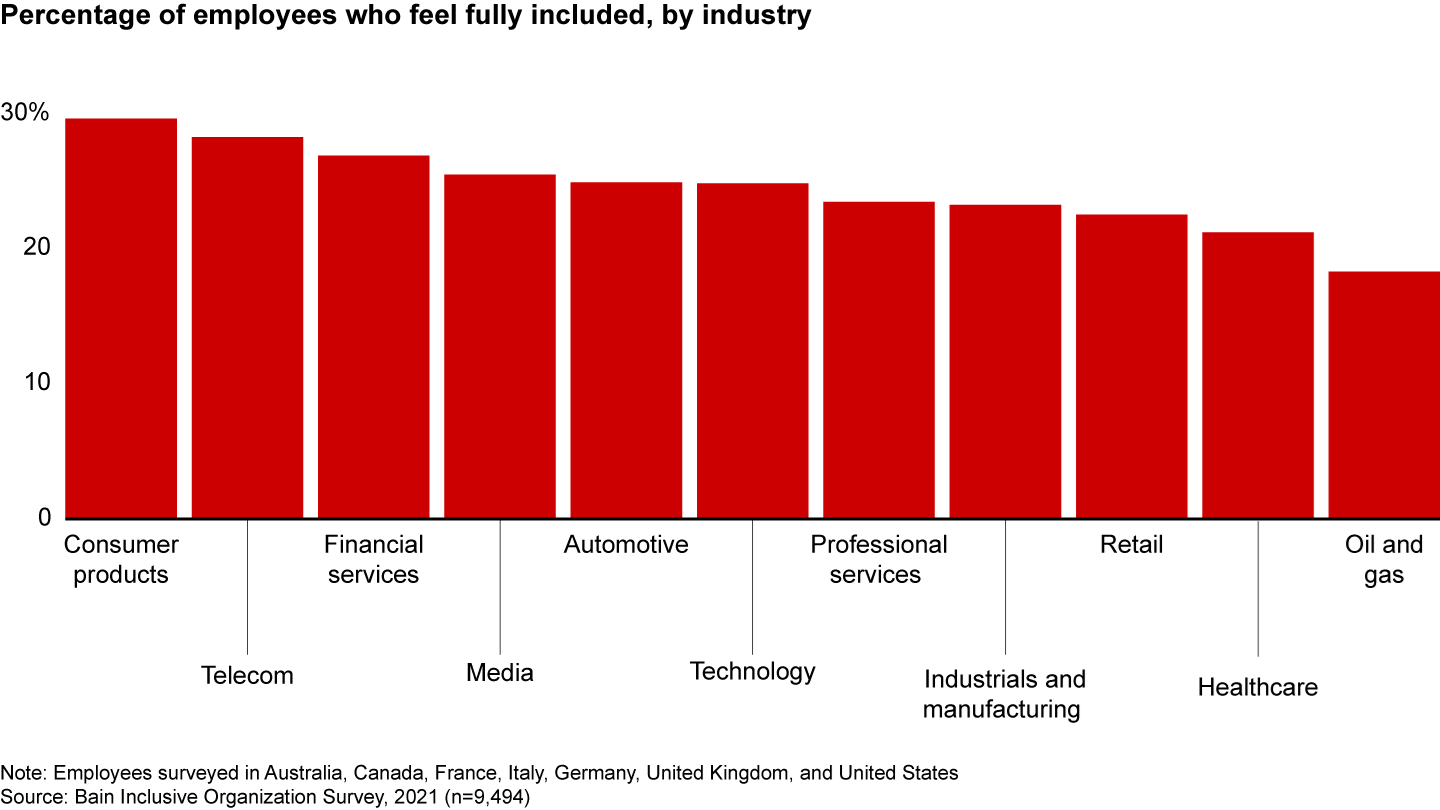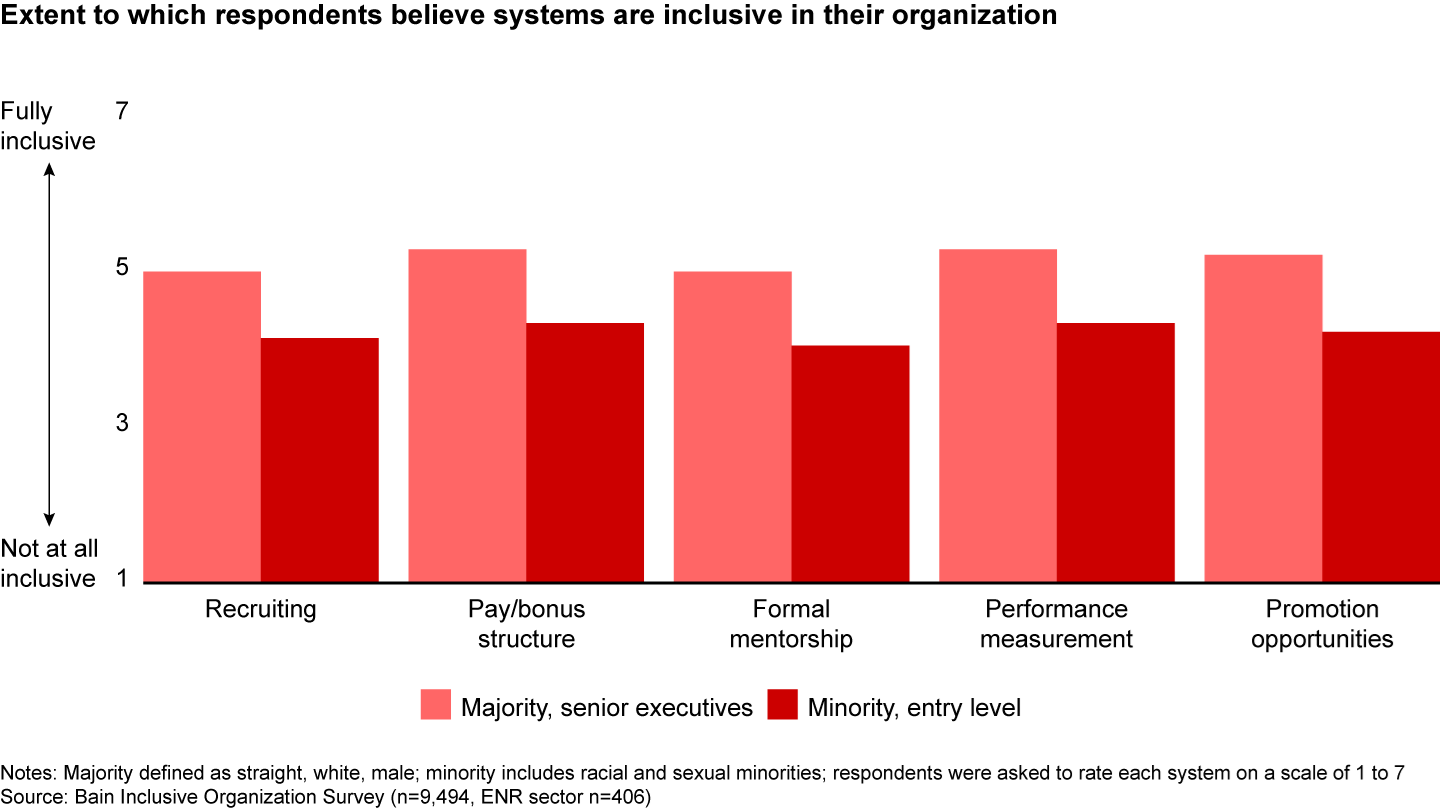Energy & Natural Resources Report

Executive Summary
- Energy and natural resources companies will need to find and integrate talent with a wide range of skills to guide them through the energy transition and help build new, greener businesses.
- Many organizations are struggling to balance acquiring talent needed to pursue new opportunities and retaining employees with the skills necessary to support legacy businesses.
- Bain's recent research on inclusion found that about 80% of employees in oil and gas view inclusion as very important in their workplace, but the oil and gas sector lags other industries in fostering inclusion.
- Leaders can help with retention and integration across talent pools by clearly signaling their commitment to the energy transition, promoting growth for individuals, and facilitating connections among employee groups.
This article is part of Bain’s Energy and Natural Resources Report 2022
Navigating the energy transition will be a generational challenge, requiring top-tier talent to solve incredibly complex problems. Meeting this challenge will require retaining and reskilling today’s workers, while integrating new people with varied backgrounds and capabilities. Leaders will need to invest in creating inclusive organizations where everyone feels like a valued contributor with a shared purpose.
Generations of talented individuals have pursued careers in energy because it offered opportunities for learning, teamwork, and impact in the service of powering our communities. This will be as true in the future as it was in the past. Looking backward, the talent that made the difference was concentrated in engineering and operational disciplines. But as the energy transition expands the range of business activities that energy companies pursue, that talent base is expanding and diversifying. Engineering proficiency is no less critical to success, but companies also need to integrate expertise in new areas such as product development, human-centered design, and regulatory affairs.
“Working in energy gives me a sense of purpose. It makes me feel I'm working on something bigger than myself, something bigger than my company.”
Talent strategy is becoming an existential priority in the energy sector. This is the result of several pressures challenging the ability to find, hire, and retain talent: a wave of retiring professionals, demand for new roles to build out new businesses, and a talent drain from the energy sector to technology, to name a few. To address these gaps, companies are rethinking how and where to expand the funnel for potential new hires, while also innovating and experimenting with new strategies to retain and reskill the workforce that keeps their current businesses running. Power utilities, for example, will need new teams to build out wind farms and battery arrays, but will also continue to require teams that can keep thermal plants running.
This isn’t the first time that the energy industry had to adapt its workforce to major changes in technology, regulation, and economics. Establishing the business models that built the modern energy landscape and building the infrastructure that delivers energy at a massive scale to power the global economy required a broad range of talent.
In more recent decades, however, as many companies’ strategies focused on incremental growth and continuous improvement, the workforce evolved to be more geared to deliver operational excellence and prudent capital management, rather than building disruptive and innovative new businesses. In the decade ahead, both are priorities.
As economies confront the need to reduce carbon emissions, the energy workforce is once again transforming. Energy companies must design employee value propositions that invite and appeal to the new talent needed for new capabilities and businesses, without threatening or alienating their current workforce.
“Multinational oil and gas companies are competing with every other big company out there for talent and need a real value proposition.”
Winning new talent with diverse new perspectives
Energy companies know they need to attract employees with new skills and capabilities, often from more diverse demographics than the current workforce. Some of this talent will need to be won over from the technology, finance, and public sectors, and they’ll bring new perspectives on teaming, compensation, and location (including remote options). Like current employees, they want to feel included in the companies they work for, and they want to know they’re experiencing an equitable talent journey, no matter their role. But in our interviews over the past year with the people that energy companies are trying to win over, many are skeptical of the motives of the industry, and doubtful of their ability to succeed in incumbent energy companies. Senior managers will need to find ways to reassure these new workers that they’re an essential part of the team, valued for their unique capabilities and perspectives.
“I want it to be clear that green investments are not just a PR stunt . . . trust would be the No. 1 factor to determine if I am interested in a job or not.”
However, in going for this new cohort, energy companies find themselves in a challenging starting position. In addition to weak representation of diverse talent, the industry lags on overall measures of inclusivity (see Figure 1).
Oil and gas trails other industries in measures of inclusivity


While most energy executives are aware of the talent crunch in their sectors and the obstacles preventing them from drawing in more diverse talent, they may be overlooking some important keys to success. Inclusivity is an important factor for career success in every sector, but especially in some energy and natural resources (ENR) industries. Bain’s recent research found that nearly four out of five employees in the US oil and gas sector rate inclusivity as very important in an employer, the most of any sector we surveyed.
“I want diversity in thinking, diversity in gender . . . more inclusion of people from different cultures and backgrounds is necessary for getting different ideas on the table.”
However, Bain’s research also found that many senior leaders may have a rosier picture of inclusivity in their companies than the new hires they’re hoping will build their careers there (see Figure 2). Across factors, senior executives rated their organizations as more inclusive than did more junior team members.
Unconscious blind spots among senior leaders can limit their ability to design the right solutions for inclusivity


These blind spots make it harder for energy and natural resources companies to know how to make their organizations more inclusive to a more diverse pool of talent. They can make it hard to stem the “leaky bucket” effect, in which well-intentioned recruiting efforts bring in racially or gender-diverse employees—who then leave soon after because they don’t feel like they belong or are included.
“My perception is that traditional energy companies right now are misaligned with what I believe.”
Bain’s recent research on inclusivity identified the factors that make ENR employees feel included. Top factors included growth opportunities, transparent feedback, a mindset for growth among leadership, and strong coaching and professional development rituals—things that would be important to anyone navigating a career path. People in underrepresented groups (including women, Black, Asian, Hispanic, and LGBTQ+) reported greater inclusion if they saw inclusion in the company’s diversity mission and goals and experienced it in team meetings, performance reviews, and team building. They also felt more included if they worked with leaders who had a growth mindset and a commitment to transparent feedback and were open to unique points of view.
Supporting current talent
While energy companies scrutinize and adapt talent strategies to include new sources and types of skills, it would be a mistake to assume that “legacy” talent profiles and preferences will remain unchanged. Most of the current energy workforce is highly motivated to support the energy transition and eager to apply their current capabilities and new skills to new missions. They’re also keen to remain relevant and valuable in an uncertain future.
“You wouldn't want to be stuck in an industry that is potentially going to be gone in 20 years; you're looking at building a 30- to 40-year career.”
The energy sector needs a skilled workforce doing many of the same things that have kept the industry running for decades—and will remain important for years to come. Yet even established roles are changing. Leaders need to continually inspire and motivate the workforce, making sure skills don’t erode, and showing these workers they remain important, valued, and included, even as their companies are transformed.
“How will the company help me transition my knowledge and experiences into something that could help the energy transition?”
The inclusion imperative
There’s no simple solution for the complex talent challenges facing the energy sector. Success will require companies to deeply engage with and draw out the full potential of new and current talent populations, and to inspire them to innovate and solve problems together, not just in parallel. We believe that improving the sense of inclusion for all employees, old and new, will be a critical enabler of the evolving talent engine required to power the energy transition.
A sincere commitment to inclusion makes organizations both higher performing and more welcoming for all workers, across lines of capability, demographics, and tenure.
Bain’s recent report on inclusion shows that employees who feel fully included are up to six times more likely to remain with their current employer, and are much more likely to promote their place of employment to others (+71 vs. ‒83, using Bain’s employee Net Promoter Score℠ methodology of calculating the percentage of promoters minus the percentage of detractors) than those who feel “not at all included.”
New employees want to have a seat at the table—to be invited to help solve the challenge of how to serve their communities in more environmentally sustainable ways. Existing employees also want to contribute to new priorities and want to know their unique skills and experiences remain valuable in an uncertain future. Inclusion won’t solve all of the complex talent challenges, but it will play a foundational role in any strategy.
Getting this right as an organization is complex in any scenario, even more so in an industry undergoing major disruption. The tactics that support and improve inclusion are nuanced. But we’ve found a few common themes across industries that feel especially relevant to today’s energy landscape.
- Signal commitment. People working in energy, both new and existing employees, are looking to know that they’re a part of the solution; that their organization is committed to thoughtfully navigating the transition; and that their perspectives are valued. Leaders should listen deeply, then talk openly and frequently about a sincere commitment to both the transition and fully including a diverse talent base.
“I want to see a clear roadmap to decarbonization and actual metrics to measure that . . . words without measurable metrics are not as convincing.”
- Promote growth. Everyone wants to build skills to navigate to the other side. Everyone wants to look ahead to a rewarding career path, characterized by deeper skills and expanding autonomy and authority. Invest in building clear, transparent career paths for new talent and helping existing talent understand lateral opportunities. Cultivate a growth mindset in leaders and give decision-making authority and leadership opportunities to the next generation to help build skills and confidence. Recognize that making this successful will require a complex set of changes to both ingrained behaviors and standard talent operations.
“I do think the scale-up of energy technologies is going to require new skills that have to be learned and developed.”
- Facilitate connection. Scrutinize the organizational silos that exist today, and guard against reinforcing them or creating new ones. New and existing employees need to be truly integrated, with an appreciation for the roles everyone plays in serving the organization’s long-term purpose and near-term strategy. Identify and experiment with tactics to strengthen connection across potential siloes, for example, through Agile teaming, cross-training, mentoring programs, and diversity affinity groups.
Navigating the energy transition will require the deliberate marriage of new and existing talent communities over many years, joining together to adopt new ways of working in support of new products and services as well as legacy business models. These are the building blocks of inclusion for a diverse population, which we see as essential to attracting, retaining, and benefiting from the full potential of the diverse talent base needed to thrive in the energy transition.